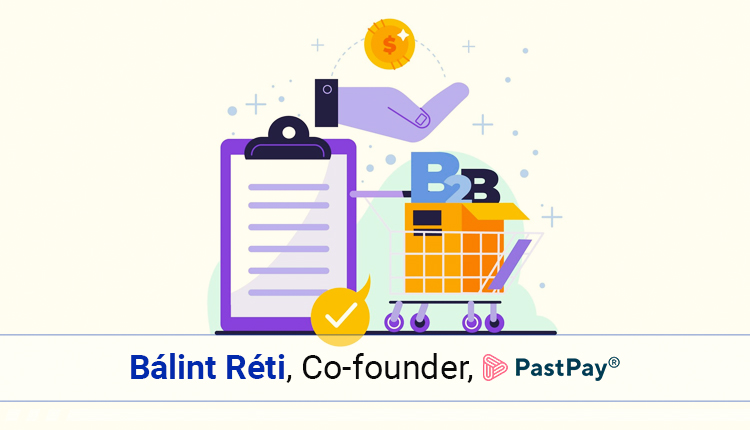By Bálint Réti, co-founder at PastPay
Remember the Buy Now, Pay Later (BNPL) trend? This modern payment method surged in popularity just a few years ago, quickly becoming a favourite among venture capitalists during the lockdown era. At the time, eCommerce shoppers, confined to their homes, embraced the opportunity for short-term financing, allowing them to spread the cost of online purchases over several payments.
However, since then, the market has seen multiple bankruptcies and the impending imposition of tighter regulations, leading to a decline. Against this backdrop, a new form of BNPL is growing in popularity, namely B2B BNPL, which has gone from strength to strength in recent years. To ensure it can achieve the success many expect it to generate, the sector must look to learn from the lessons that have come before it.
So, without further ado, here’s the three things I believe the B2B BNPL sector can learn from its B2C counterpart to ensure sustained success:
1 – Remember Responsibility Rules the Field
On paper, the first wave of BNPL presented a more responsible and accessible way to make deferred payments on big-ticket items. This was certainly the initial premise of the movement, but over time it’s fair to say that its popularity was fuelled by other factors. Most notably, BNPL soon gained a reputation for being used by individuals to make everyday purchases, especially against a backdrop of rising prices and inflation.
Whether this was the intention of B2C BNPL providers or simply an unintended consequence of systems ill-prepared to handle the surge in activity is up for debate. Unfortunately, what isn’t in question is that the sector became entangled in negative perceptions—primarily due to its portrayal as exploiting vulnerable individuals who found themselves in challenging economic circumstances.
Nothing tarnishes the appeal of a growing industry like negative press. In just a few months, BNPL went from being one of the most exciting financial developments in years to one of the most criticised. While B2B BNPL is better positioned to avoid many of these issues, those in the sector must always remember the importance of acting responsibly. Once a pristine reputation is lost, it’s incredibly difficult to regain—so let’s do everything we can to protect it.
Read More : Ensuring PCI DSS Compliance in Finance
2 – Beat Regulation to the Punch
The rising tide of financial regulation across Europe has been one of the major trends of recent years. Everywhere you look, regulators seem to be taking a more stringent approach and actively seeking oversight on sectors they previously allowed to develop organically. B2C BNPL is a prime example of this shift. As early as 2021, regulators across Europe were already engaged in discussions about the need to bring the sector under stricter regulation.
Regulation, in and of itself, is not a bad thing—in fact, it can provide the structure needed to help a sector grow responsibly. However, when an industry gains a reputation as an unregulated ‘wild west’ and regulation is introduced to counteract this perception, it often results in more draconian measures that can hinder innovation and unsettle external stakeholders evaluating its future viability.
Although regulations around B2C BNPL are still largely undecided, there is a sense that, when they do come into effect, they will be particularly stringent. Much of this could have been avoided if the sector had done a better job of self-regulating from the outset. Ultimately, the B2C BNPL industry could have been more proactive in managing this aspect of its development, which might have allowed it to pre-empt regulatory intervention.
3 – Prioritise Value Over Volume
The overarching lesson that the B2B BNPL sector can take from its B2C counterpart is the importance of prioritising value over volume. As previously mentioned, some B2C platforms appeared to deviate from their original purpose—to offer an accessible and affordable way to split payments into multiple instalments—and instead became a tool used by individuals to make purchases they possibly couldn’t afford.
That was never the true value of B2C BNPL, and by losing sight of this, companies began to tarnish the reputation of the broader field. Given the intense competition within the sector, it’s easy to see why prioritising volume became so tempting. However, this focus on short-term gains ultimately resulted in long-term challenges; ones the sector is still grappling with today, which has led to issues across the field.
Moving forward, B2B BNPL must remain committed to upholding the true value it offers to business customers—primarily its ability to optimise cash flow and support strategic, productivity-enhancing investments. Being selective and having the confidence to turn down enquiries that appear irresponsible will be crucial for its long-term growth strategy. This approach could be the key to enabling the sector to achieve the success we all anticipate.
For more information about PastPay, please visit: https://pastpay.com/en
Read More : Global Fintech Interview with Jon Briggs, Head of Commercial Product & Innovation at KeyBank
[To share your insights with us, please write to psen@itechseries.com ]
